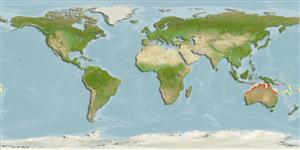Elasmobranquios (tiburones y rayas) (sharks and rays) >
Carcharhiniformes (Ground sharks) >
Carcharhinidae (Requiem sharks)
Etymology: Carcharhinus: karcharos (Gr.), sharp or jagged; rhinus, an ancient name for sharks, from rhine (Gr.), rasp, both words alluding to a shark's jagged, rasp-like skin (See ETYFish); fitzroyensis: -ensis, Latin suffix denoting place: Fitzroy River, Queensland, type locality (See ETYFish).
Eponymy: This is a toponym; the holotype was collected in the estuary of the Fitzroy River, Western Australia. (Ref. 128868), visit book page.
More on author: Whitley.
Environment: milieu / climate zone / depth range / distribution range
Ecología
marino; salobre demersal; rango de profundidad 0 - 40 m (Ref. 6871). Subtropical; 10°S - 26°S
Distribución
Países | Áreas FAO | Ecosistemas | Ocurrencias, apariciones | Point map | Introducciones | Faunafri
Western Pacific: northern Australia, from Western Australia to Queensland. Recorded in the Arafura Sea (Ref. 9819).
Length at first maturity / Tamaño / Peso / Age
Maturity: Lm 94.5, range 89 - 100 cm
Max length : 135 cm TL macho / no sexado; (Ref. 6871)
Espinas dorsales (total) : 0; Espinas anales: 0. Bronze above, fading to grayish brown after death and in preserved specimens; light below, without conspicuous markings on fins; no conspicuous white band on flanks (Ref. 9997).
A little-known shark found inshore and offshore on the continental shelves from the intertidal to at least 40 m depth (Ref. 9997). Feeds mainly on teleost fishes, also crustaceans (Ref. 6871). Viviparous (Ref. 50449). Utilized for human consumption (Ref. 244, 9997) and probably for the oriental shark fin trade (Ref. 244).
Viviparous, placental (Ref. 50449). Females give birth to 1-7 pups every year between February and May (Ref. 6871). Size at birth about 50 cm (Ref. 6871). Distinct pairing with embrace (Ref. 205).
Compagno, L.J.V., 1984. FAO Species Catalogue. Vol. 4. Sharks of the world. An annotated and illustrated catalogue of shark species known to date. Part 2 - Carcharhiniformes. FAO Fish. Synop. 125(4/2):251-655. Rome: FAO. (Ref. 244)
IUCN Red List Status (Ref. 130435: Version 2024-1)
Threat to humans
Harmless
Human uses
Pesquerías: escaso valor comercial
Herramientas
Special reports
Download XML
Fuentes de Internet
Estimates based on models
Preferred temperature (Ref.
123201): 26.1 - 28.7, mean 27.7 °C (based on 294 cells).
Phylogenetic diversity index (Ref.
82804): PD
50 = 0.5000 [Uniqueness, from 0.5 = low to 2.0 = high].
Bayesian length-weight: a=0.00331 (0.00184 - 0.00595), b=3.08 (2.93 - 3.23), in cm total length, based on LWR estimates for this species & Genus-body shape (Ref.
93245).
Nivel trófico (Ref.
69278): 4.1 ±0.6 se; based on size and trophs of closest relatives
Resiliencia (Ref.
120179): Muy bajo, población duplicada en un tiempo mínimo superior a 14 años (Fec=1).
Fishing Vulnerability (Ref.
59153): Very high vulnerability (81 of 100).
